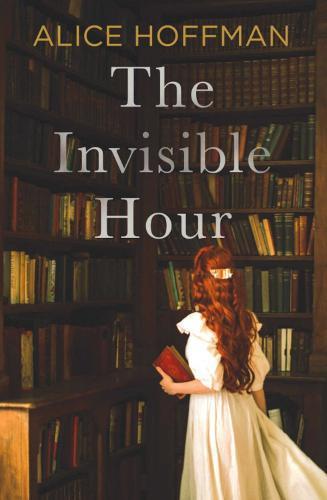
Best known for her Practical Magic series, Alice Hoffman delivers a time-travelling homage to the power of books in The Invisible Hour.
This novel charts the lives of a mother and daughter and their search for independence and control over their lives. Ivy Jacob grows up in a rich but emotionally distant household. She rebels as a teenager and becomes pregnant to a man who abandons her. When she turns to her father for help, he ejects her from the house, worried about his reputation. Ivy seeks refuge in a community in Massachusetts that preaches love and understanding, but is controlled by an abusive and oppressive man, Joel Davis.
Life on the farm was austere and laden with rules that covered nearly every action and every hour of the day. Anyone who disobeyed was punished and all doubters were cast out. The rules were memorized and recited by the children twice a day, at dawn and at dusk … No contact with original families. No contact with the outside world and their judgements. No reading novels or attending public school … Children belong to everyone. Love is everywhere. There is only one family, and it is us.
Ivy gives birth to a daughter, Mia, who is claimed by the leader of the cult – now Ivy’s husband – Joel Davis. Ivy has been well educated and understands the power dynamics of the community. Most galling to her are two things: first, the necessity for children not to identify with their mothers but to be brought up in the Children’s House, and the second is the ban on reading books. Ivy and Mia cultivate a secret bond between them and Ivy encourages Mia to go to the library and read. They are found out and punished numerous times, shamed in front of the community, beaten and their hair shorn.
Ivy dies in a farm accident when Mia is a teenager. By this time, Mia has developed a relationship with the local librarian, Sarah Mott, and is borrowing books. Mia takes the books back to the farm where she hides them and reads them in secret in her precious few minutes of free time. On the shelf of classics, she finds a first edition of The Scarlet Letter that has an inscription from the author, Nathaniel Hawthorne, addressed to Mia, even though the book was published in 1850.
Mia is discovered with the stash of books and shamed in front of the community.
Pages fluttered like doves aflame, the burned bits of paper soaring into the dark, silent night. In the morning, Mia would be branded with an iron in the shape of an A. She would carry it with her all her life.
Mia runs away and seeks refuge with the librarian. Because Mia and Sarah are harassed by a violent Joel Davis, Sarah moves Mia to her girlfriend’s place. Here, Mia attends school and then university, and grows up in a loving household. She continues to read voraciously and trains to become a librarian.
So far, so straightforward. While staying with Sarah and Constance, Mia finds out that Nathaniel Hawthorne once lived nearby. She walks at night to think and watch the stars. One night she walks into a clearing and is transported back to the nineteenth century and meets Nathaniel Hawthorne. This is long before he has written The Scarlet Letter, when he was struggling as a young writer.
‘Is that a story I might know?’ he asked, always most comfortable when speaking about books, for literature, he had always found, held more for him than life, which seemed a dark tunnel from which he couldn’t escape.
‘You wrote it.’ Mia held up the volume with a brown cover and gold letters.
Nathaniel laughed and said, ‘Not likely. Not if it’s any good.’
On this day, when he stood before Mia, Hawthorne was in his early thirties and he already considered himself to be a literary failure, having no idea of what he was to become.
He overlooks the obvious things – that she is dressed differently and does not behave like a nineteenth-century woman. They fall in love, he sets her up in a cottage, they sleep together and Mia becomes pregnant.
The Invisible Hour is a time-travelling fable, a morality play where the protagonists, Ivy and Mia, learn that their instincts for learning and independence are true and that the restrictions imposed on them by the patriarchy are a trap for all women. Mia also understands that these are not new ideas, that writers have been exploring them for a long time.
As I understand it, Nathaniel Hawthorne’s writing is a personal love of Alice Hoffman’s. She found characters in the pages of his books who were struggling with issues of being an outsider as she did when she was a child.
The book is a great paean to the power of knowledge, books and reading, and the freedom and imagination to be found within their pages.
Alice Hoffman The Invisible Hour Scribner 2023 PB 252pp $32.99
Linda Godfrey is a poet, editor and teacher. She has a chapbook of poetry, Count the Ways, published by Verity La. Linda won the 2021 AAWP First Chapter: a pathway to publication prize. She lives on the Dharawal land of the Wodi Wodi people, on the south coast of New South Wales.
You can buy The Invisible Hour from Abbey’s at a 10% discount by quoting the promotion code NEWTOWNREVIEW or you can buy it from Booktopia.
You can also check if it is available from Newtown Library.
If you’d like to help keep the Newtown Review of Books a free and independent site for book reviews, please consider making a donation. Your support is greatly appreciated.
Tags: Alice | Hoffman, book burning, Massachusetts, Nathaniel Hawthorne
Discover more from Newtown Review of Books
Subscribe to get the latest posts sent to your email.






